Ball valve du15: device and installation features
How does the ball coupling DN15? How good is it against the background of more familiar screw and cork valves? What do the numbers on the case mean? What you should pay attention to when installing it yourself? In our material we will try to answer these questions.

Device
What we will see, having disassembled the spherical crane with a diameter of 15 millimeters?
- The main element of the product is a brass ball with a chrome coating and a through channel almost equal to the DU of the pipe being attached.
Practical consequence: when the valve is open, its hydraulic resistance is minimal, since the transitions of diameter and turbulence are practically absent.
- The tightness of the movable connection with the body is provided by two fluoroplastic or teflon rings.
- The same ring seals the stem outlet through the valve body. From above, it is tightened by a washer.
- Finally, the rod is driven by a convenient handle in the form of a lever or the so-called butterfly.
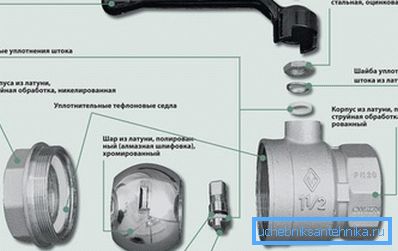
Comparison with competitors
How does the ball valve DU 15 look in comparison with classmates - screw and cork valve?
To begin with, let's hit the black PR campaign and recall the key shortcomings of the competition.
Screw valve
- The flow of water can flow through it only in one direction - so that it presses the valve from below. Otherwise, there is a risk of a series of hydraulic shocks due to valve beating in a turbulent flow or even its complete separation from the stem.
- The body of the screw valve collects scale and sand. Just because of its complex shape and the presence of pockets with a slow flow of water.

- The same complex shape of the body and a relatively small opening of the valve seat ensures a high hydraulic resistance of the valve and, consequently, a drop in pressure when water is disassembled by more than one plumbing fixture.
- The gland packing leaks even with a long simple valve. With frequent use of it, packing of the gland is needed at least once every six months. With rubber seals, the picture is not much better: with active use, sealing rings are produced, and when idle, they lose elasticity.
- Rubber valve gasket has a limited service life. The reason is the same - loss of rubber elasticity. Its destruction is sharply accelerated by sand that has fallen under the valve.
By the way: valves with all-metal ground-in valves, without gaskets, are more durable. But, when debris falls under the valve, the valve simply does not overlap.
Plug valve
- To turn the cork requires a very significant effort. There is always the risk of disrupting the nearest pipe fitting or thread.
- Leaking of the gland when turning the plug is guaranteed in this case. Not only that: for stuffing box gland you need not only to shut off the valve itself, but also to reset the riser of water supply or heating. Otherwise, there is always a risk that the disturbed plug will fly out of the casing at the water flow front.
Ball valve
And how does the ball joint clutch D15 look on this dull background? The direction of water flow is of no importance for the operation of the valve. The valve will not come off due to the lack thereof.
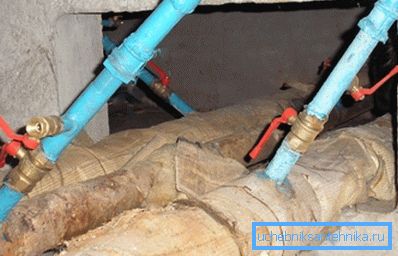
Slag accumulations in the housing can not be afraid. An open valve tends to collect sand and scale no more than any section of a straight pipe.
We have already mentioned the low hydraulic resistance: it differs little from the resistance of a section of a pipe of the corresponding diameter.
Teflon or PTFE sealing ring around the stem due to its own low coefficient of friction and the quality of the stem treatment practically does not wear out during operation and does not degrade when idle. The same applies to the sealing rings adjacent to the surface of the ball inside the valve.
To clarify: in the author's practice, there were cases when a 15 mm ball valve was leaking along the rod. Basically, they belonged to inexpensive Chinese products and were eliminated with their own hands by simple winding under the clamping washer of the FUM tape.
The smooth surface of the ball and the material of the seals guarantee a small amount of force required to open or close the valve. This applies not only to small-sized products: for example, the ball-shaped flange valve DU150, which has very solid dimensions, is also blocked by a standard handle without the application of excessively large force.
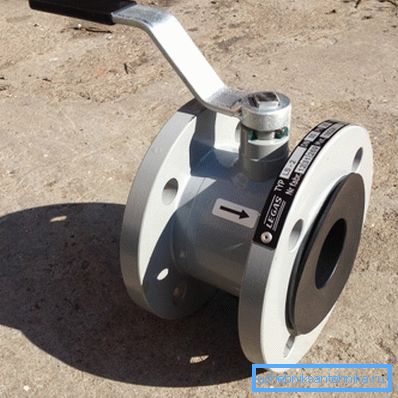
With all these advantages, the price of ball valves is approximately equal to the cost of cork and screw analogues, and often it turns out to be completely below. The conclusions are quite obvious.
Ball valves 15 for 15 mm screw or cork valves are definitely not worth changing: they are better than competitors on all counts. The same applies to valves for pipelines with a higher capacity: a 150 mm ball valve is in most cases more convenient, more practical and more durable than a cast iron or steel valve of the same size.
Marking
The main technical characteristics of the ball valve DU15 are indicated in the marking on its body. This applies to both domestic products and imported goods.
| Designation | Parameter value |
| Do DN | Nominal bore (compatible pipe thread size) |
| RU, PN | Maximum working pressure in kgf / cm2 or MPa |
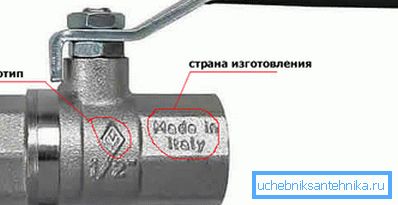
It is worth mentioning a few subtleties.
- Conditional pass can be specified in inches. The size of interest - DU15 - corresponds to 1/2 inch.
- As a rule, the working pressure of domestic products is indicated in atmospheres (kgf / cm2), and import pressure is indicated in megapascals (MPa). So, marking DN50 RU40 means that the valve with a nominal passage of 50 mm is designed for a pressure of 40 atmospheres; The DN15 PN8 0 MPa ball valve is attached to a half-inch thread and can withstand a pressure of 8 megapascals (80 atmospheres).
Selection and installation
What to look for when buying a valve?
How to put it right?
- Body should be brass. From fragile silumin products it can be distinguished by weight: brass is noticeably heavier.
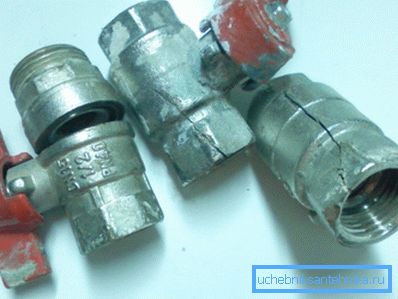
By the way: a simple instruction will help you not to be mistaken. Choose not silvery, but yellow gates. If chromium can be any metal or alloy, the lack of coating will not leave any doubt.
- The handle - lever is much more convenient than the handle - butterfly. But it makes sense to use a butterfly only with a lack of space near the valve.
- It is best to seal the threaded connection with a polymer thread. (Tangit Unilok and analogues). It does not require much effort during assembly and does not leak when there is a slight reverse course of the thread.

- By the way, about the effort: do not tighten the valve on the thread until it stops. Brass is not steel; It is possible to break with excessive force not only silumin body.
- At the time of installation, it is better to simply remove the interfering handle..
Conclusion
We hope that our material will help the reader with the choice of valves for home plumbing. The video in this article, as usual, contains additional thematic information. Successes!